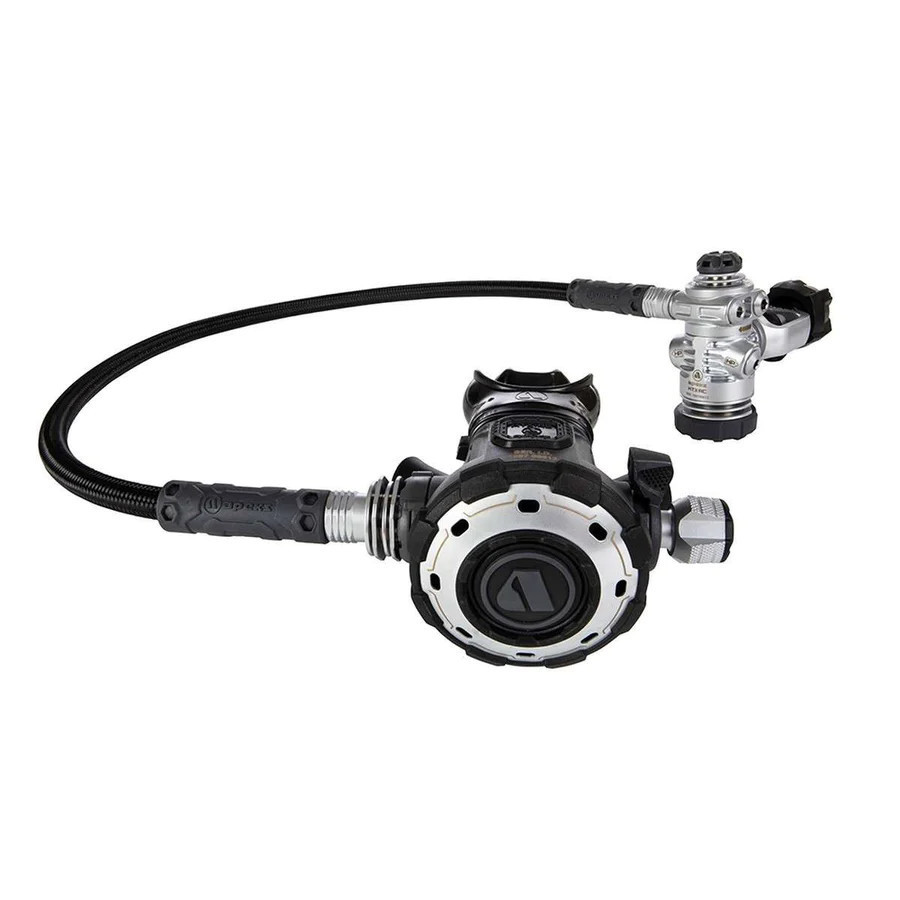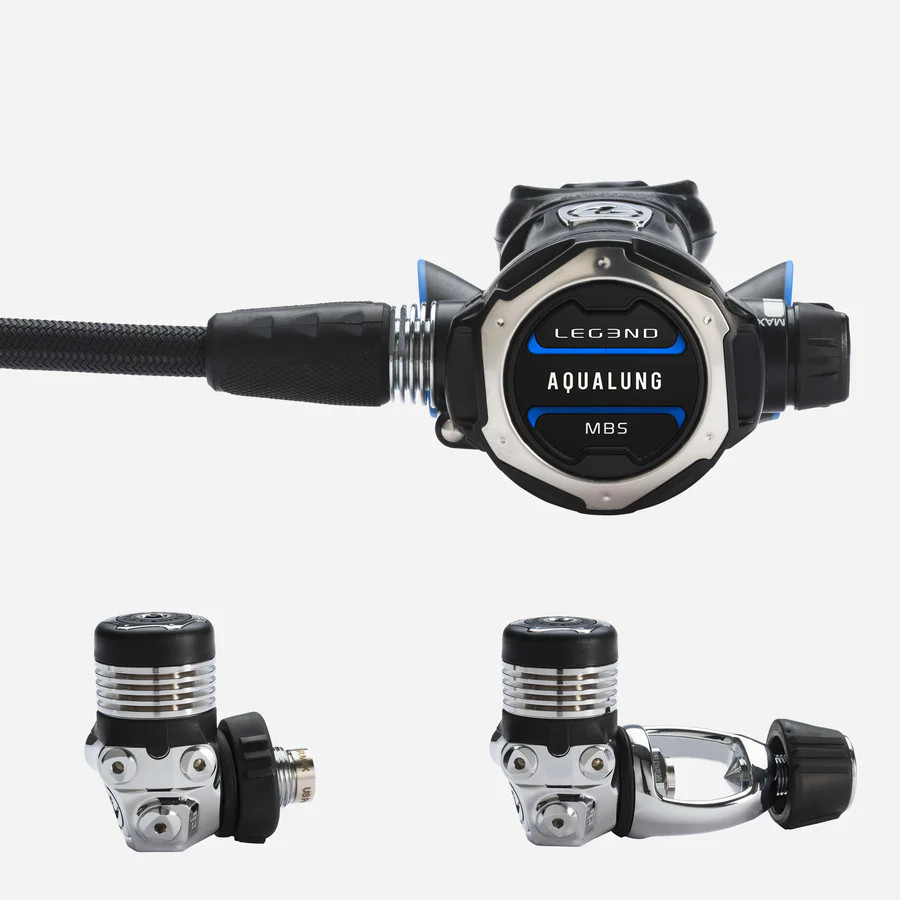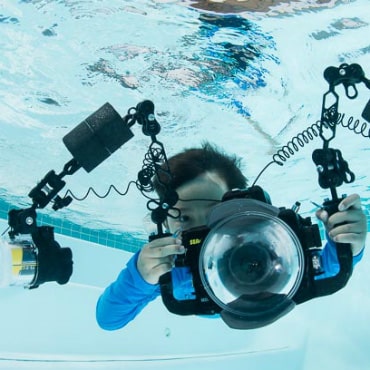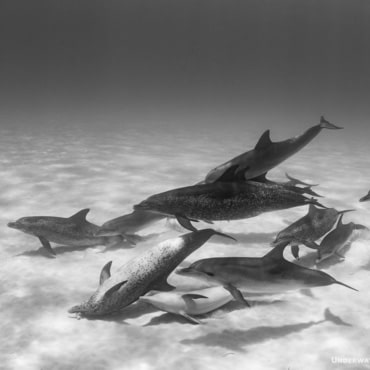Best cold water regulator
Posted by Elma Tarr on October 2nd, 2024

Here’s how they work:
Two-Stage Design (Like Standard Regulators)
Freeze-Resistant Features
Environmental Sealing of the First Stage
- Cold water regulators often feature an environmentally sealed first stage, which prevents water from coming into direct contact with internal moving parts. By sealing the first stage, the regulator avoids exposure to freezing water, reducing the risk of ice formation inside the mechanism.
- The environmental seal is often a flexible diaphragm that transmits the water pressure to the regulator without letting water in.
Heat Exchangers
- Many cold-water regulators incorporate heat exchangers, usually made of metal, which help dissipate the cold generated by the pressure drop. These are fins or plates located around the first or second stage that absorb and transfer ambient heat to the freezing parts of the regulator, preventing ice formation.
- The metal used (often brass or chrome) helps conduct heat away from the regulator, keeping it above freezing temperature
Anti-Freezing Materials
- Components inside cold water regulators are often made of materials that resist freezing, like silicone-based lubricants and special non-metallic parts. These help to prevent ice buildup on key moving components, ensuring smooth operation even in icy conditions.
Second Stage Freezing Prevention
- In the second stage, where air expands before reaching the diver’s mouth, some cold-water regulators use venturi assist mechanisms to prevent free flow or freezing during exhalation.
- The purge button and other external elements are also designed to avoid freezing by having reduced surface areas or protection from direct water contact.
Increased Air Flow Capacity
- Cold water regulators are often designed to provide a greater flow of air to avoid restriction in colder environments. This ensures that the diver is getting enough air, even when temperatures are low and breathing resistance may naturally increase.
Balanced vs. Unbalanced Regulators
- Balanced regulators are often preferred for cold water diving because they provide consistent airflow regardless of tank pressure or water temperature. This is crucial in cold environments where equipment needs to be reliable under stress.
Breathing Comfort Adjustments
- Many cold-water regulators have adjustments for breathing effort, which can be fine-tuned to match the diver’s needs in cold environments. This prevents over-exertion, which could lead to heavier breathing and potentially increase the risk of free-flowing air or freezing.
Cold Water Testing
- Cold water regulators are tested in simulated cold-water conditions to ensure they function reliably. Regulators that are approved for cold water use typically meet standards such as the EN250:2014 certification, which ensures the regulator can perform in extreme conditions.
The Mares ABYSS 22 NAVY II Regulator is considered a top choice for cold water diving due to several key features:
- The regulator’s first stage is environmentally sealed, preventing water from entering and freezing around internal components. This is critical for cold water dives, where temperatures can cause unsealed regulators to freeze and malfunction.
- The Mares Abyss 22 Navy II is EN250A certified, meaning it has passed stringent tests for use in temperatures as low as 2°C (35.6°F). This cold-water certification ensures it will perform reliably in extreme environments.
- The second stage of the regulator is made of marine-grade metal, which allows for better heat exchange and reduces the chance of freezing. The metal acts as a heat sink, pulling warmth from your exhaled breath to keep the second stage from icing up.
- Mares’ **VAD system** ensures smooth airflow at any depth, reducing breathing resistance and making it easy to breathe even in colder, denser water.
- The Superflex hose remains flexible in cold temperatures, unlike traditional hoses that can become stiff. This makes the regulator more comfortable to use in cold environments, providing greater mobility and reducing strain on the regulator connection.
- The Navy II version of the Abyss 22 was specifically designed and tested to perform in the harshest conditions, including military and professional divers' requirements for extreme cold water operations.
- The metal second stage helps retain moisture from exhaled air, preventing the dry mouth sensation often felt in cold water dives.
- The first stage is equipped with high-flow ports, ensuring maximum gas delivery to the diver, which is crucial in cold environments where exertion may increase air consumption.
Environmentally Sealed First Stage
Cold Water Certification
All-Metal Construction
Vortex Assisted Design (VAD)
Superflex Hose
Reliable Performance Under Extreme Conditions
Efficient Moisture Retention
High Flow Ports
These features collectively make the Mares Abyss 22 Navy II one of the top regulators for cold water diving, offering safety, comfort, and reliability even in icy conditions.
The Aqualung Legend MBS regulator is an excellent choice for cold water diving due to a combination of advanced features designed to prevent freezing and ensure reliable performance in low-temperature environments. Here's why it's a great cold water regulator:
- The first stage of the Legend MBS is dry-sealed to prevent water from entering the internal components, which eliminates the risk of ice formation around the parts. This ensures consistent performance even in extremely cold water conditions.
- The Master Breathing System (MBS) allows for easy, single adjustment of breathing effort. This feature makes it user-friendly by integrating the Venturi effect and cracking pressure into one control. In cold water, where breathing demand may increase due to denser air, the MBS makes it simpler to adjust the regulator for smooth, effortless breathing.
- Aqualung’s ACD system automatically closes off the first stage when the regulator is disconnected from the tank. This helps to keep moisture and contaminants out of the first stage, preventing freezing and corrosion. In cold environments, this is crucial as any moisture inside the regulator can freeze and disrupt performance.
- The over-balanced diaphragm ensures consistent airflow at all depths. In cold water, increased depth adds pressure and makes breathing more difficult. The Legend MBS compensates for this by increasing intermediate pressure as depth increases, ensuring easy breathing at deeper, colder dives.
- The second stage features a series of heat exchangers that surround key components to prevent freezing by absorbing warmth from the surrounding water or your exhaled breath. This helps keep the second stage from icing up during a dive.
- The Legend MBS is designed for extreme conditions and is EN250A certified for cold water use. It has undergone rigorous testing to ensure it functions optimally in cold environments as low as 2°C (35.6°F), providing peace of mind for cold water divers.
- The second stage uses a combination of lightweight, corrosion-resistant materials, making it durable and reliable in cold, saltwater environments. The second stage diaphragm is designed to be highly resistant to low-temperature conditions.
- The Comfo-Bite mouthpiece reduces jaw fatigue, which is particularly important in cold water where dry, cold air may cause discomfort during prolonged dives.
- The regulator has a Venturi lever that directs air efficiently, helping to prevent free flow in cold water. This minimizes the risk of gas wastage, which can be problematic in colder environments where air consumption is higher due to physical exertion.
- The second stage offers both left and right hose configurations, making it versatile and adaptable for different gear setups in cold water. This adds to its flexibility for technical divers who might dive in extreme cold environments. With its combination of an environmentally sealed first stage, heat exchangers, easy breathing adjustments, and durable build, the Aqualung Legend MBS is designed to deliver optimal performance in the coldest water environments, making it a reliable choice for cold water divers.
Environmentally Sealed First Stage
MBS (Master Breathing System)
Auto-Closure Device (ACD)
Over-Balanced Diaphragm First Stage
Heat Exchangers
All-Terrain Use
Durable Materials
Comfo-Bite Mouthpiece
Efficient Venturi Lever
Multiple Second Stage Configurations
The Cressi T10-SC PVD/Master regulator is a solid choice for cold water diving due to its specialized design features that enhance its reliability and performance in low-temperature environments. Here’s why it excels as a cold water regulator:
- The first stage of the T10-SC is environmentally sealed to prevent water, contaminants, and debris from entering the internal components. This is crucial in cold water to prevent freezing, which can lead to malfunction.
- The T10-SC model has a PVD (Physical Vapor Deposition) coating on the metal parts, which makes the regulator more resistant to wear, corrosion, and saltwater damage. This helps it maintain performance in harsh, cold environments by enhancing the longevity of critical components.
- The second stage features an efficient heat exchanger that surrounds the valve mechanism, transferring heat from the surrounding water or the diver’s exhaled breath to prevent freezing. This is particularly important in cold water where temperature fluctuations can lead to icing of the second stage.
- The balanced diaphragm first stage ensures consistent airflow regardless of depth or tank pressure. In cold water, where the air is denser, this feature guarantees that you will always have a steady, easy breathing experience even at greater depths or with lower tank pressure.
- The T10-SC regulator is designed with high-quality anti-corrosion materials, which are essential for cold water and extreme environments. The regulator's lightweight design adds comfort without sacrificing durability, making it easier to carry during long or technical dives.
- The Master second stage offers micrometric breathing adjustments that allow the diver to fine-tune the inhalation effort. This is particularly useful in cold water diving, where increased air density and exertion can lead to higher breathing resistance. Fine-tuning helps maintain a smooth, easy breathing experience.
- The second stage is engineered with anti-freeze properties, making it suitable for cold water dives. Its design reduces the likelihood of free-flow or freezing, even in sub-40°F (4°C) water, ensuring safe, uninterrupted breathing throughout the dive.
- The first stage is equipped with high-flow intermediate pressure ports, which maximize air delivery to the second stage. In cold water, increased effort from exertion or colder, denser air can require more airflow, and this feature ensures that the regulator can meet that demand with ease.
- The second stage includes a Venturi effect control that allows divers to switch between pre-dive and dive modes. This helps reduce the risk of free flow on the surface or during entry into cold water, making it easier to control the regulator in extreme conditions.
- The over-balanced design of the T10-SC ensures that intermediate pressure increases as the diver descends, ensuring that the regulator compensates for increased depth and pressure. This is especially important in cold water dives where depth can increase the difficulty of breathing, but the over-balanced design makes inhalation easier at any depth.
- The Cressi T10-SC PVD/Master is certified for use in cold water environments, having undergone rigorous testing to ensure it can handle temperatures as low as 2°C (35.6°F). This certification provides assurance that the regulator is equipped to perform in cold, harsh diving conditions.
- The second stage features an ergonomic design with a large purge button that’s easy to use even with thick cold-water gloves. This adds to the ease of use in colder water where dexterity may be reduced due to temperature.
Environmentally Sealed First Stage
Advanced PVD Coating
Efficient Heat Exchange System
Balanced Diaphragm First Stage
Durable and Lightweight Construction
Comfortable Breathing with Micrometric Adjustment
Second Stage Anti-Freezing Technology
High Flow Ports for Optimal Air Delivery
Pre-Dive Venturi Control
Over-Balanced Design
Reliable Cold Water Certification
Comfortable Ergonomics
The Cressi T10-SC PVD/Master is a great cold water regulator due to its environmentally sealed first stage, advanced anti-freeze features, heat exchanger system, and robust materials. It provides reliable, consistent airflow and resists freezing, making it a dependable choice for divers venturing into cold water environments.
Why Freezing is a Problem:
- Air Restriction: Ice formation can block the flow of air, making it difficult or impossible for the diver to breathe.








